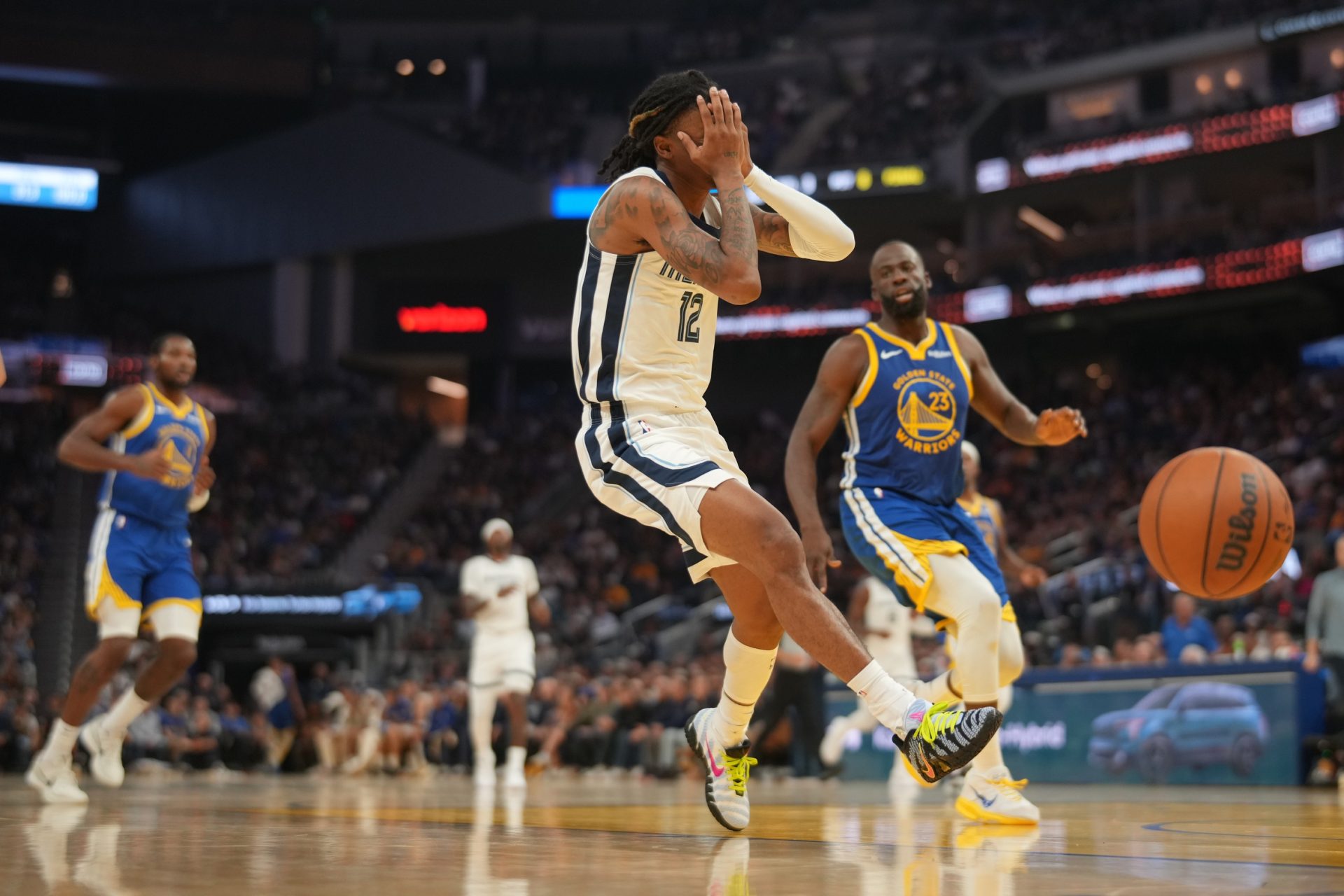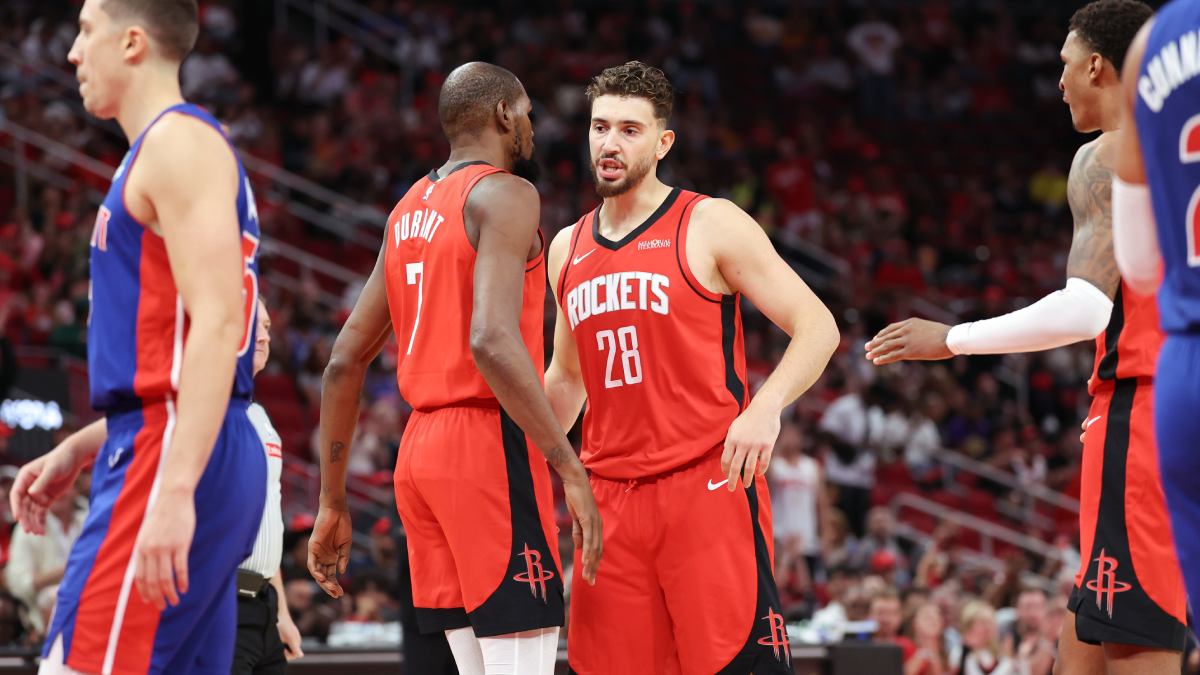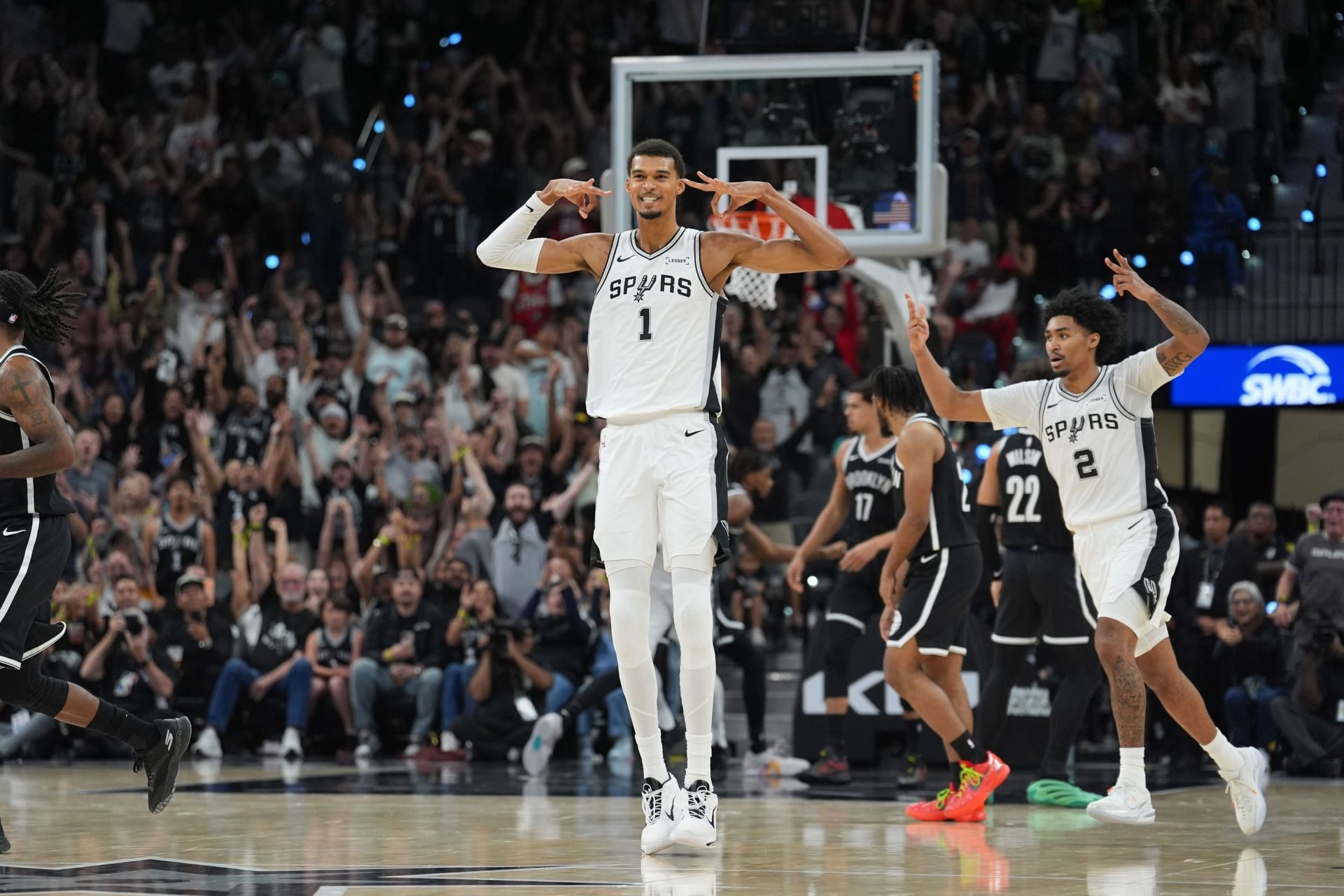A few months ago, I noted that the NBA’s official stats page periodically adds new metrics to better show what’s unfolding on the floor.
That day, I focused on one of my favorite charts, the STREAM. Today, we’re diving into the latest heavy-hitter, launched in October 2024. In other words, we’ve just seen its debut season.
And now that a certain video just went viral, it’s a good time to check how this rookie stat has performed. We’re talking about the compelling Dunk Scores, a section intended to be an ‘objective judge’ when rating dunks as if it were All-Star Weekend— but with a far stricter and more limited margin for discretion.
No Barkleys or O’Neals handing out ‘50s’ for free. Pure NBA Stat: cold, clinical, and zero bias.
Under this new spotlight, the player generating the most heat is Quentin Grimes in his pre-76ers era, back when he wore a Dallas Mavericks jersey and took on the towering Luke Kornet (7-foot-1).
The most complete (and maybe best?) dunk of the 2024/25 season.
From here, the question is obvious: how exactly is this hybrid of stats and official judgment calculated? What elements make a dunk more than just a two-point play? The NBA boils it down to one concept and three pillars: technique, athleticism, and difficulty.
Drawing on objective metrics from advanced optical tracking systems and AI models that analyze every motion down to the millimeter, the program produces a score that doesn’t depend on who performs the dunk or the game situation. It’s a kind of automated “Slam Dunk Contest” with a scientific framework meant to scrub away any trace of subjectivity.
Structure of the ‘Dunk Score’
All well and good… technique, athleticism, and difficulty: it sounds great but is easily malleable.
To avoid that pitfall and hold to the most neutral approach, the model evaluates more than 25 attributes from each play, all taken directly from player tracking. From there, it generates a final value split into four main ‘subscores’: Vertical, Power, Style and Defensive Response.
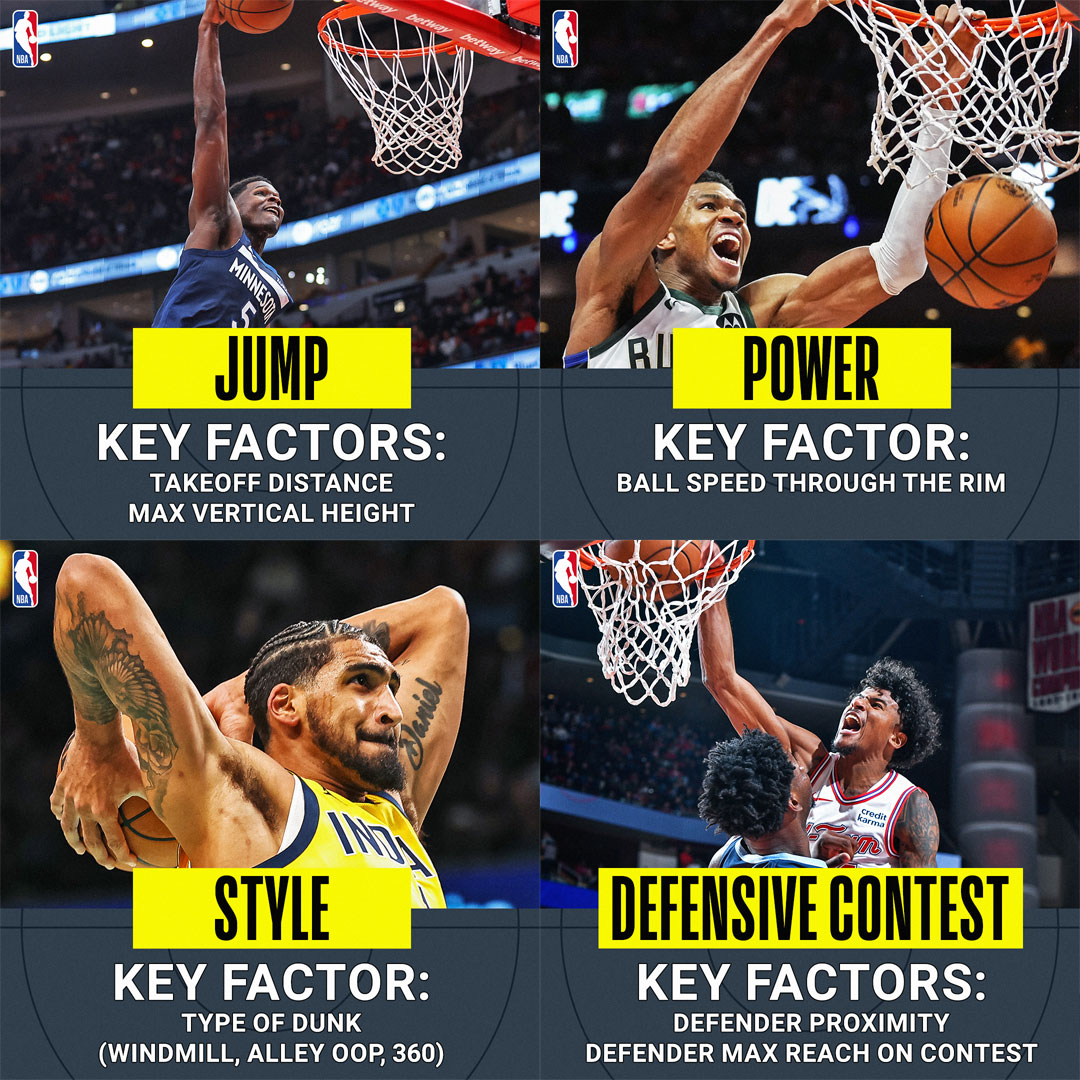
The first measures explosiveness and leaping ability. The second gauges the raw force behind the dunk. The third adds the aesthetic component: how much flair, finesse, or innovation the player shows. And the last brings a crucial factor that’s anything but minor: it accounts for the level of defensive resistance the dunker faced.
So, a transition jam with no one in front of you isn’t the same as one that clears two defenders, with contact included and a 360 spin.
For now, the system doesn’t grant bonuses for momentum or narrative (winning a playoff game with an alley-oop, for example). It simply standardizes each technical factor that makes a dunk even more difficult or spectacular.
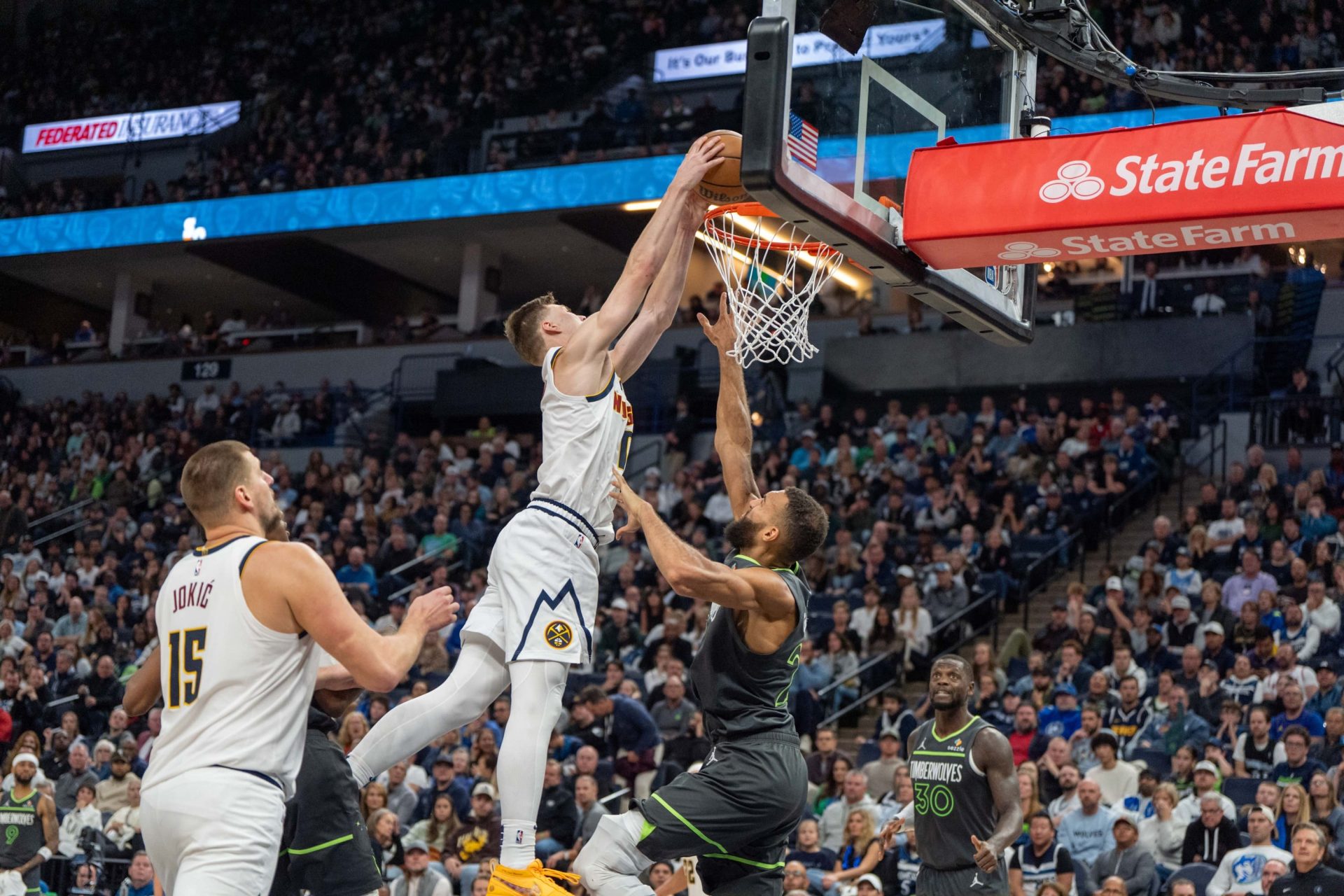
‘Breaking Down’ the Dunk
Some of the most relevant data feeding this model includes a player’s maximum height (measured from the hips and relative to takeoff), the takeoff distance from the rim, hang time, the ball speed as it goes through the cylinder, the ball’s total acceleration during the play, and the ball’s total distance traveled; combined, these factors help distinguish a straightforward dunk from one set up by more complex moves, like windmills, double clutches, or through-the-legs jams.
There are also binary variables that detect specific gestures: whether or not the dunk was backward, if there was body rotation, if it came with an alley or a self-oop, and so on.
The Role of the Defense
One of the most welcome aspects of the Dunk Score is how it incorporates defensive resistance. While the absence of a defender isn’t penalized, it does reward the extra difficulty of throwing it down against opposition.
To do that, the system calculates a Defensive Contest Level based on the defender’s distance, angle, and hand or arm position relative to the ball. It also incorporates metrics like the Alignment Score, which measures the initial distance between defender and attacker, and the Collision Score, which gauges the intensity of their contact.
The model can even detect situations where the defender tries to draw a charge, or if the dunker jumps right over the defender.
A parameterized thrill.
Distribution of Scores
According to retroactive data from the 2023/24 season, most dunks fell in the 20 to 50-point range. In other words, simple, practical finishes generally prevail over flashy displays. Only a handful reached elite numbers.
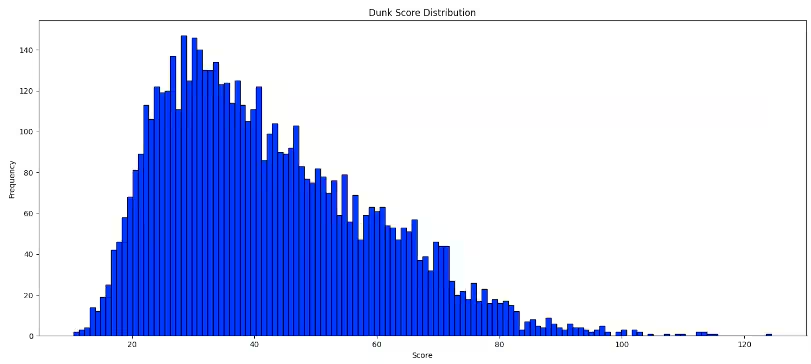
This model is brand new, so we shouldn’t be overly critical yet. It’s still in beta, with plenty of room for improvement and new variables to consider (maybe factoring in the score, standings, or the game’s emotional context is relevant?)
For now, thanks to this metric–both unique and ambitious– what used to be raw perception or reptilian instinct is mapped onto a tangible scale. On that scale, Quentin Grimes’ dunk from January 25, 2025 ranks at the top with an average of 118.2.
- Final score: 118.2
- Vertical: 90
- Power: 95
- Style: 82
- Defense: 81
To wrap things up with a bit more action and color, here are a few dunks that hit (or came closest to) a perfect score (100) in each of the four categories.
Vertical
Here’s that famous viral tweet featuring a single name: Shaedon Sharpe. The Blazers guard occupies half the top 10, but even his best jump still fell short of 100, checking in at 97.7.
TOP 10 VERTICALES 24-25 🚀
10) S. Castle -100cm
9) SHAEDON SHARPE -101cm
8) A. Edwards -101cm
7) J. Green -102cm
6) M. Monk -102cm
5) SHAEDON SHARPE -103cm
4) SHAEDON SHARPE -104cm
3) SHAEDON SHARPE -111cm
2) J. Morant -111cm
1) SHAEDON SHARPE -114cm pic.twitter.com/8knQBpqnXS— nbamaniacs (@nbamaniacs) July 23, 2025
Power
Leading in power and control as the wood floor’s own “Pirelli ambassadors,” Obi Toppin and Miles Bridges—with a 99.5—top the category where sheer force rules.
Am I the only one slightly let down, or did you expect more too? The lack of resistance lowers the wow factor on the power scale.
Style
This is where we see something closest to a true dunk-contest vibe, and here six players earn a perfect score: Shaedon Sharpe (windmill), Kai Jones (Harden alley-oop), Obi Toppin (between-the-legs, x2), John Collins (windmill), MarJon Beauchamp (off the glass) and Ivica Zubac (another Harden alley-oop).
None of them—in my opinion—is truly mind-blowing. But we have to pick, so I’ll go with these two: Jones’s dunk—both for the pass and its timing control—and Collins’s windmill for its fluid and complete execution (better than Sharpe’s, if you ask me).
Defense
We’ve arrived (and we’ll close) with my favorite part: the dunks that really make you jump out of your seat. These are the ones where there’s genuine intent on both sides—the risk of getting posterized or delivering a block.
Four perfect defensive scores: Christian Braun (vs Gobert), Goga Bitadze (vs Antetokounmpo), Charles Bassey (K. George) and Daniel Gafford (vs Kuminga).
The Nuggets guard’s is easily the best, but the other three, in my admittedly subjective opinion, aren’t as visually striking as this Zion Williamson slam, which pulled a 93.8 on the defensive scale.
The Best of the Playoffs
We’ll top things off with the highest-rated dunks from the knockout rounds.
Anthony Edwards vs. Warriors
Anthony Edwards vs. Lakers
Myles Turner vs. Bucks
Malik Beasley vs. Knicks
Alperen Sengun vs. Warriors
What About the 4 Dunk Contest Participants?
It’s paradoxical—for lack of a better word—that the four hopefuls aiming to win the Slam Dunk Contest 2025 don’t appear once in that entire highlight reel above. But that’s how it is.
The four players who competed for a show that’s been on the decline since the days of ‘Gordon vs. LaVine’ were Mac McClung (three-time champion), Andre Jackson Jr., Matas Buzelis, and Stephon Castle.
Of those four, McClung (on a two-way deal and logging just two brief appearances) never even got a chance to throw down with the main roster all season. And only the Spurs’ Rookie of the Year delivered a dunk truly worth mentioning, scoring a 96.6.
Buzelis’s top mark was 87.6, while Jackson Jr. topped out at 82.9 with his best throwdown.
(Cover photo by Kevin Jairaj-Imagn Images)


